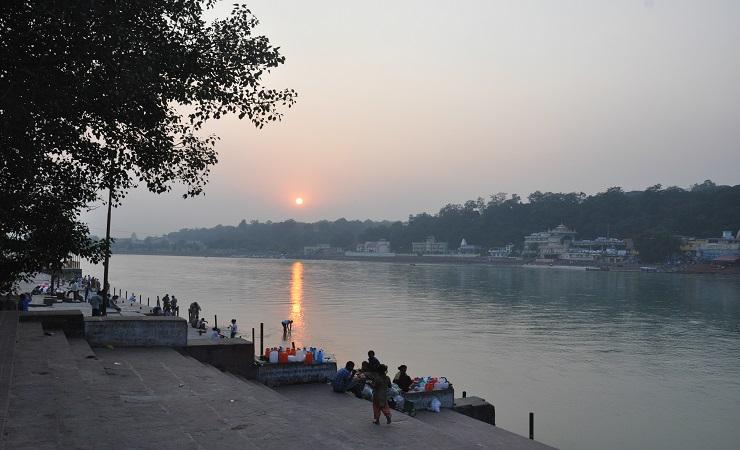ASIACALLING
Melting glaciers causing the holy Ganges river to shrink
"The River Ganga is under threat. The Himalayan glaciers that feed directly into the river could vanish by 2030, according to a recent report by the United Nations."

In India, the river Ganges, or the Ganga, is not just a river.
The Ganga is a place of deep spiritual significance, worshiped as a goddess, considered like a holy mother.
But the Ganga is under threat.
The Himalayan glaciers that feed directly into the river could vanish by 2030, according to a recent report by the United Nations.
Asia Calling’s Jasvinder Sehgal travels to the banks of the Ganga in the northern town of Rishikesh to find out more.
The sun is setting and hundreds of people have converged on the bank of Ganga.
Many of them are dressed in saffron clothes and they’re seated around a pyre, as they sing hymns in praise of the river goddess.
The smell of sandalwood incense floats heavily in the air.
But the prayer rituals carried out at the water's edge may not last forever – or even another generation.
Swami Chidanand Saraswati is leading the prayers and says Indians are obligated to protect the holy river.
“To me if Ganga dies, India dies. If Ganga thrives, India thrives. Losing a glacier means losing life, water is life, water is a blessing. That’s why it’s our prime duty to save the glaciers,” said Swami Chidanand Saraswati.
The Ganges has long flowed thick and strong.
But researchers say that climate change is having a serious impact on the holy river.
Rising temperatures are causing the glaciers that feed the river to melt at rapid speeds, explains geography professor BG Sharma.
“In this area the temperature has risen by 0.9 degrees. Due to the rise in temperature, the glaciers are melting so fast. At this speed, there are chances that by the year 2030, these glaciers that feed the Ganges won’t exist anymore,” Sharma stated.
Professor Sharma has been studying the glaciers in the Himalayan mountains for sixteen years.
Globally, the Himalayas are a significant region for glaciers.
“There are 46 thousand glaciers in the Himalayan region and 614 such glaciers feed water to the river Ganges. But out of that number more than 400 glaciers are melting at a very high speed.”
Professor Sharma tells me the glaciers are receding by 23 meters every year.
Back at the prayers by the river I meet senior journalist Mahesh Sharma.
He wrote a book about the history of the Himalayas and travels to the glaciers every year.
In the past three decades he has seen radical change in the glaciers.
“In the year 1983, I went to the Gomukh glacier for the first time in my life. This is the glacier from where the river Ganges originates. This year when I went there, I saw a radical change. The glacier has broken and been pushed back by 1.5 kilometers.”
Mahesh Sharma continued, “as the Himalayas have the highest numbers of glaciers in the world, global warming will affect the entire world.”
For more in our series on climate change: Dealing with India's mountains of e-waste
The are many glaciers in the Himalayan region.
One of those glaciers, called the Gangotri, provides up to 70 percent of water to the Ganges during the dry summer months.
It is shrinking at a rate 36 meters per year—nearly twice as fast as it was 20 years ago.
Sixty-eight-year-old Chote Lal Chaurasia has run a cobbler shop at the banks of Ganges for the last 45 years.
He has noticed a change in the river too.
“Four months ago, the level of the river Ganges suddenly dropped.
Lai Chaurasia continued, “I have seen for the first time in my life people walking in the Ganges to another bank. The water level was below the waist height.”
The 1,568-mile Ganges provides water for drinking and farming for more than 500 million people.
The World Wildlife Fund has listed the river Ganges among the world's most endangered rivers.
And people here in Rishikesh are deeply worried about the fate of the river.
On my way home I start talking to taxi driver Bharose Nand Kukreti.
Bharose is 48 now and he tells me that as a child there was big waterfalls connected to the river that he used to play in.
Now, he says, they are just tiny streams, and the river is polluted.
As this Indian film song says – “God your Ganges is shrinking and getting dirty because of continuously washing the sins of people”
For more in our series on climate change, check out these stories
Timor Leste's eco warriors hit the beach
In Kabul, where the rivers run dry
The long walk, Philippines climate activist Yeb Saño
- Jasvinder Sehgal
- Ganges River
- Climate Change
- Himalayas
- Himalaya glaciers
- Mahesh Sharma
- BG Sharma
- climatelensasia
Komentar (0)
KBR percaya pembaca situs ini adalah orang-orang yang cerdas dan terpelajar. Karena itu mari kita gunakan kata-kata yang santun di dalam kolom komentar ini. Kalimat yang sopan, menjauhi prasangka SARA (suku, agama, ras dan antargolongan), pasti akan lebih didengar. Yuk, kita praktikkan!